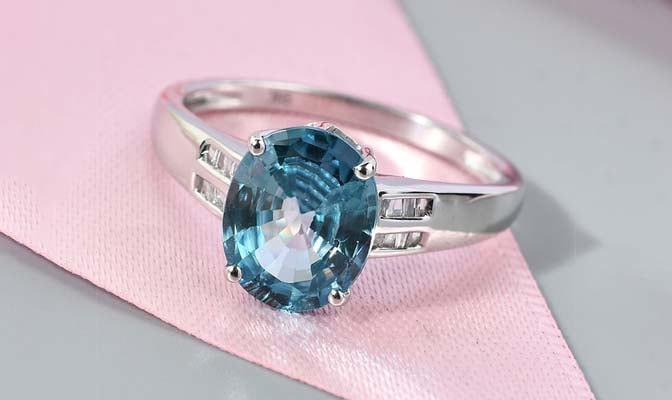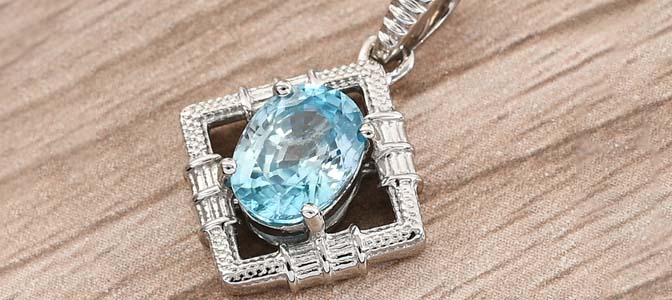
Introduction
This beautiful gemstone is widely known for its sparkling dazzle. The gemstone gets its name from the Persian language referred to as Zargun, meaning gold hued. The English name Zircon is derived from Zirkon which is derived from German. Belonging to the family of nesosilicates, it’s chemically known as Zirconium Silicate. The natural colour of zircon ranges and varies from being colourless to red, brown, blue, green and yellow-golden.
Zircons are known to have a high refraction index with a strong dispersion which emphasises their brilliant dazzle. Large zircons are very rare as they occur as small grains in sedimentary and metamorphic rocks. Although this gemstone is very resistant to heat and corrosion but Zircons tend to undergo internal radiation owing to their high content of Uranium and Thorium, thus causing internal modification of crystal structure, density decrease and change of colour.
If treated under high heat, common brown coloured Zircons tend to change colours to colourless and blue colours under the heat of 800-1000 degrees. The variety of pinks and reds occur under geological conditions of hundreds of years.

Origin & Supply of Zircon
Zircons are a common constitute of most sands and more easily found in sedimentary deposits. Zircon is also known to be one of the oldest gemstones to be found on the face of earth. Its oldest reference can be found in the Bible, being adorned by high priests of Israel. The first discovery of Zircon came in the year 1789 by Martin Heinrich Klaproth, who while studying one sample from Ceylon named the element Zirkonerde. Later, in the early 1800s, an English chemist by the name Sir Humphry Davy gave the element its name of Zirconium.
Today, Zircon is a common gemstone widely found. A lot of countries throughout the world boast of its sourcing. Tanzania boasts of large zircon crystals, China is a source of some bright coloured ones such as oranges and reds, Cambodia leads in the segment of the bright green variety of this gemstone and Australia dominates the rich plum coloured variety. This popular stone can also be found in Madagascar, Sri Lanka, Ukraine, USA, Canada and Myanmar.
SHOP NOWHow is Zircon Mined
For over 2000 years, Zircon was being mined from stream gravels to extract the beautiful gemstone, but now the gem is extracted by dredging the sedimentary deposits. These deposits can be in beach, littoral or alluvial sediment deposits. After the gravel and sedimentary deposits are collected, they are purified through spiral concentrators which separate them on the basis of their density. The elements like ilmenite and rutile are then removed by electrostatic and magnetic separators to obtain Zircon. A specific gravity ranging from 4.6-4.7 allows it to be extracted mechanically.
The best gem-grade zircons are mined from alluvial deposits found mainly at Sri Lanka. Cambodia, Myanmar and Vietnam. Deposits mined for gem-grade of this gemstone must contain crystals of atleast several millimetres with good clarity. Zircons are basically formed due to the weathering of carbonated and other type of rocks associated with hydrothermal activity. The best grade Zircons are mined and extracted directly from the cavities in pegmatite.
SHOP NOW

Features of Zircon
A good quality Zircon should be free of impurities or any crystal cracks or chips. The few important factors that play an important role to determine its grade are: Origin, colour, clarity and cut. However some of the following points put us through the features of a good zircon stone.
- Zircons have an adamantine lustre
- The transparency of crystals varies from transparent to translucent
- Zircons range in varied colours such as brown, colourless, orange, red, yellow, blue, black and green
- The crystal portrays dipyramidal and prismatic habits
- The cleavage of this gemstone is indistinct but mostly prismatic
- Mohs hardness is 7.5
- Fracture is uneven
- Specific gravity ranges from 4.6-4.7
- This gemstone has white streak
- Has a high refractive index ranging from 1.92-2.01
- Other Characteristics: they are sometimes found fluorescent and the darker crystals may be highly radioactive owing to the inclusions of rare earth minerals in them.
- One of the hardest gemstones, the zircons can exist for billions of years in the earth’s crust

Types of Zircons
As discussed above, this gem ranges in a variety of vivid hues. Some of them are found and mined naturally while a large percentage is treated to achieve their bright colours. The brilliance of this stone is not be missed, their dazzling shine and unmistakable sparkle is never a disappointment. Furthermore, the names of the varieties with their names are as follows:
- Jacinth: Also known as a synonym for Hyacinth, this variety displays the colours of yellow, brown, orange and red as varieties of Zircon. Some state that this variety holds reference to the biblical times which are not much used today.
- Jargon: A colourless, pale yellow and grey variety of Zircons
- Matura Diamond: The trade name for the colourless variety of Zircons also known as Sparklite widely.
- Starlite: A heat treated variety that brings out the brilliant greenish- blue colour of Zircons. This coloured variety is rarely natural and is thus created.
- Beccarite: The most popular variety of Zircons are beccarite and they possess the beautiful lustre of a green colour.
- Stremlite: The beautiful blue coloured variety comes under this category name.
- Melichrysos: The subtle and bright variety of yellow zircons can be found in this variety.

Benefits & Uses of Zircon
Zircon is a beautiful gemstone which is widely available globally in a number of colours with a perk of being light on your pocket. They possess many benefits which range from astrological advantages, healing properties to jewellery designing. Zircon is believed to be widely used as a substitute for diamond.
Following are the benefits of Zircon Stones:
- Zircons are believed to encourage Physical and mental strength of its wearer
- This beautiful gem in known to increase focus and concentration and is thus used while meditation.
- Not to forget Zircons are a beautiful substitute for Diamonds and hence these are commonly and widely used for jewellery making in the forms of: Rings, earrings, bracelets, necklace, bangles, etc.
- Known to bring visions and dream to reality by adorning this gem stone.
- You can attain physical, emotional & spiritual balance with the use of this gem
- Light your life as wearing this stone is believed to bring abundance and prosperity into your life
- Achieve overall harmony as you adorn this gem because it is also known to clear any blocked energies in the body.
- Zircon is also believed to aid and sort some of the health issues and diseases.
- The stone is known to enhance the memory of the wearer.
- Zircons are believed to bring peace and purity to the heart
- Known to increase the creativity, rationality, interest in factual details and curiosity of the wearer
- Its magical abilities making it a renowned stone which helps in decreasing negativity and feelings to deception from a persona mind
- The strong feelings of confidence and power are blessed on the wearer as they wear this stone
- The blue variety of Zircons are associated as a birth stone for the month of December
This Gemstone has many astrological and spiritual benefits as mentioned above but it is popularly used in jewellery making for its cost effective benefits as a substitute for Diamonds and their brilliant dazzle that wins everyone’s fancy.

What to remember while buying Zircons
As always the 4 Cs to be kept in mind while buying Zircons are Carat weight, Clarity, Cut & Colour of a gem stone. Owing to their similar appearance to Diamonds, a well cut Zircon Gem can be distinguished by the double refraction that it exhibits as compared to the single refraction by diamonds. When a Zircon is accurately cut and faceted it displays maximum lustre which further enhances its light performance.
These are widely available as faceted stones but other shapes include oval, round, pair, marquise, trillion, emerald step and radiance to mention a few.
Zircons are known to have high levels of clarity but being a natural stone, inclusion of slight impurities is common and which is often visible through magnification. This gem is mostly transparent or translucent with a vitreous lustre. Some of them are heat treated to enhance or add colour and transparency, the higher the transparency of the stone relates to its high value and a sought after piece.
Zircons are commonly and largely found in small sizes, the larger variety is rare to come by and commands higher prices. Known to be one of the densest gemstones, the Zircon stones range with a higher weight in a smaller size. The above mentioned factors highly influence the cost of this gemstone. Commonly, the Zircon gemstone is popular to be an inexpensive gemstone as a substitute for diamonds with its benefit leading to its stunning brilliance at an affordable price.
Facts about Zircon
- Popular as one of the three birthstones for the month of December
- The colourless or white Zircon is associated with the planet Venus, which is known to bring good fortune to Taurus and Libra sun signs
- Zircon contains traces of Uranium which can lead it to change properties by irradiating itself
- The Blue Zircon variety was popularize by the name ‘Starlite’ because of the gems stunning brilliance by George Kunz from Tiffany
- Owing to their higher range on the Mohs scale of hardness, Zircons are durable and chemical resistant.
- Zircons are known to have additional layers grow around the original crystal just like the tree rings which help in recording geological events.
- The brilliance of Zircons is such that it has intrigued geo scientist to form the discipline of “Zirconology”

FAQ's
Is Zircon a natural gem stone?
Zircon is a beautiful natural gem stone which is highly durable with a strong dispersion.
How strong is Zircon?
Zircon is a gemstone with high physical durability which ranges at a 7.5 hardness on Mohs scale.
What does Zircon symbolize?
This gem stone is believed to be useful for multiple benefits such as aiding holistic balance, keeps you calm and positive while checking on your negative energies. Also known to instil self-confidence and purity along with prosperity.
What is Zircon used for?
Zircon is widely used in jewellery making owing to its similarity with diamonds. It is also used as a pigment for glazes, stains used for ceramics and pottery, a whitening agent, an opacifier, etc.
How common is Zircon?
Zircon is one of the most common gemstone found globally and owing to its low price, it is widely used everywhere.
How to clean Zircon?
It is fairly easy to clean Zircon. Dip your jewellery in a mixture of warm water with mild soap. Brush it with a soft-bristled toothbrush to remove any dirt. Rinse the jewellery to ensure there is no soapy residue left and then dry it with a soft clean cloth.
What is the most popular colour of Zircon?
Zircons are widely used and are known for their wide variety of coloured zircons. But, the most popular of all varieties after the colourless one is the Blue coloured Zircon. This colour has also often one the fancy of many and is a variety which is much sought after.







































